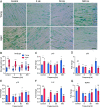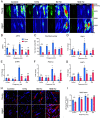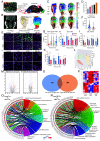Silver electroceutical technology to treat sarcopenia
- PMID: 37549292
- PMCID: PMC10438839
- DOI: 10.1073/pnas.2300036120
Silver electroceutical technology to treat sarcopenia
Erratum in
-
Correction for Kim et al., Silver electroceutical technology to treat sarcopenia.Proc Natl Acad Sci U S A. 2023 Oct 24;120(43):e2316531120. doi: 10.1073/pnas.2316531120. Epub 2023 Oct 18. Proc Natl Acad Sci U S A. 2023. PMID: 37851679 Free PMC article. No abstract available.
Abstract
While the world is rapidly transforming into a superaging society, pharmaceutical approaches to treat sarcopenia have hitherto not been successful due to their insufficient efficacy and failure to specifically target skeletal muscle cells (skMCs). Although electrical stimulation (ES) is emerging as an alternative intervention, its efficacy toward treating sarcopenia remains unexplored. In this study, we demonstrate a silver electroceutical technology with the potential to treat sarcopenia. First, we developed a high-throughput ES screening platform that can simultaneously stimulate 15 independent conditions, while utilizing only a small number of human-derived primary aged/young skMCs (hAskMC/hYskMC). The in vitro screening showed that specific ES conditions induced hypertrophy and rejuvenation in hAskMCs, and the optimal ES frequency in hAskMCs was different from that in hYskMCs. When applied to aged mice in vivo, specific ES conditions improved the prevalence and thickness of Type IIA fibers, along with biomechanical attributes, toward a younger skMC phenotype. This study is expected to pave the way toward an electroceutical treatment for sarcopenia with minimal side effects and help realize personalized bioelectronic medicine.
Keywords: electroceutical; integrated electrical stimulation biochip; multiplex screening technology; personalized electric medicine; sarcopenia.
Conflict of interest statement
The authors declare no competing interest.
Figures






References
-
- Cruz-Jentoft A. J., Sayer A. A., Sarcopenia. Lancet 393, 2636–2646 (2019). - PubMed
-
- Marty E., Liu Y., Samuel A., Or O., Lane J., A review of sarcopenia: Enhancing awareness of an increasingly prevalent disease. Bone 105, 276–286 (2017). - PubMed
-
- Parise G., Snijders T., Myostatin inhibition for treatment of sarcopenia. Lancet Diabetes Endocrinol. 3, 917–918 (2015). - PubMed
Publication types
MeSH terms
Substances
LinkOut - more resources
Full Text Sources

